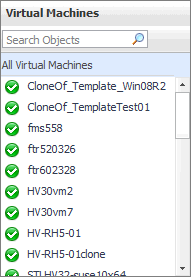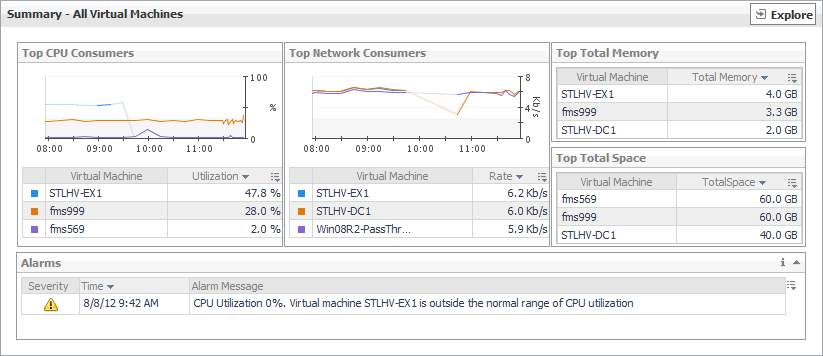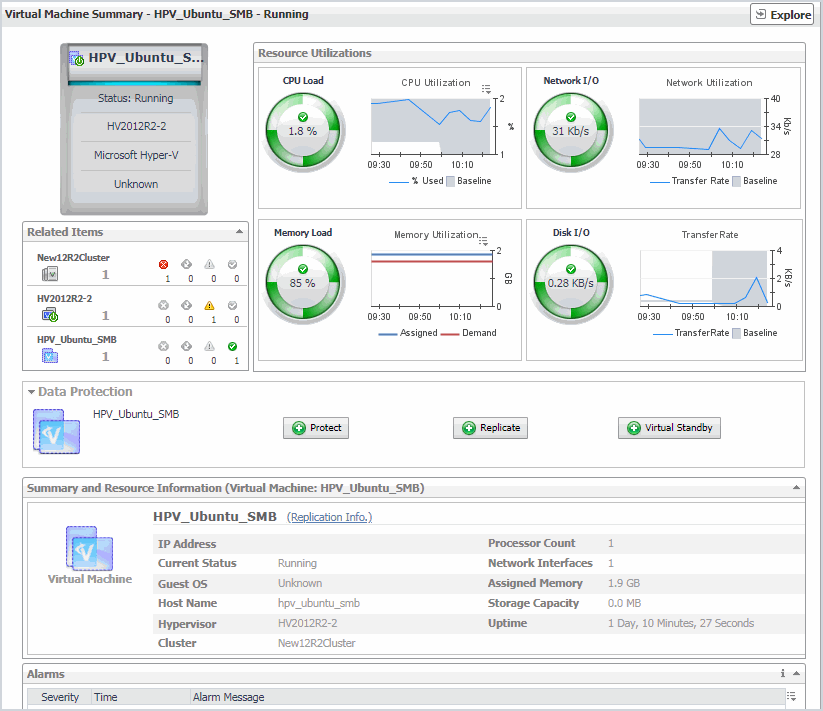Virtual Machines view
The Virtual Machines tree view lists the virtual machines existing in your environment and shows their state.
This view appears in the Quick-View on the left when you select the Virtual Machines tile in the Virtual Environment view.

Selecting the All Virtual Machines node displays overall resource utilization for all virtual machines in your integrated system and the elements that consume the highest amount of system resources in the Summary - All Virtual Machines view on the right. Similarly, selecting a virtual machine node shows virtual machine-specific metrics in the Virtual Machine Summary view on the right.
Summary - All Virtual Machines view
The Summary - All Virtual Machines view displays overall resource utilization information for a group of virtual machines and shows the elements that consume the highest amount of system resources.
This view appears in the Quick-View on the left when you select All Virtual Machines in the Virtual Machines view.

This view is made up of the following embedded views:
Virtual Machine Summary view
The Virtual Machine Summary view shows the overall resource utilization and the amounts of system resource consumption for a virtual machine.
This view appears in the Quick-View on the left when you select a virtual machine in the Virtual Machines view.

This view is made up of the following embedded views:
|
|
Shows the numbers and states of the cluster and the server on which the selected virtual machine is running, and the virtual machine running on the selected server. |
|
|
|
• |
Cluster. The name of the cluster in which the selected virtual machine is running, followed by the counts of all alarms associated with the cluster, broken down by the alarm state (Normal, Warning, Critical, Fatal). | |
|
|
|
• |
Server. The name of the server on which the selected virtual machine is running on, followed by the counts of all alarms associated with that server, broken down by the alarm state (Normal, Warning, Critical, Fatal). | |
|
|
|
• |
Virtual machines. The name of the selected virtual machine, followed by the counts of all alarms associated with that virtual machine, broken down by the alarm state (Normal, Warning, Critical, Fatal). | |
|
|
Drill down on: |
|
|
|
• |
Alarm count. Displays a dwell that shows the objects against which alarms are generated. |
|
|
|
|
• |
Cluster. Displays the Clusters dwell, showing the name and state of the cluster in which the selected virtual machine is running. |
|
|
|
|
• |
Server. Displays the Servers dwell, showing the name and state of the server on which the selected virtual machine is running. |
|
|
|
|
• |
Virtual Machines. Displays the Virtual Machines dwell, showing the name and state of the selected virtual machine. |
|
|
|
Shows the resource consumption for the selected virtual machine, broken down into four simple views. |
|
|
|
• |
CPU Load. The current percentage of the selected virtual machine’s CPU load, used to execute system code and user programs, based on the total CPU capacity allocated to that virtual machine. | |
|
|
|
• |
CPU Utilization, % Used. The percentage of the virtual machine’s CPU utilization spent on executing system code and user programs during the selected time period. | |
|
|
|
|
|
|
• |
Disk I/O. The current disk I/O rate for the selected virtual machine. | |
|
|
|
• |
Disk Transfer Rate. The rate at which data was read from or written to the disks associated with the selected virtual machine during the specified time period. | |
|
|
|
|
|
|
|
|
|
• |
Memory Load. The current percentage of the average memory usage by the selected virtual machine. |
|
|
|
|
|
|
|
|
|
|
• |
Network I/O. The current rate at which the selected virtual machine transfers data from and to the network. | |
|
|
|
|
|
|
|
|
|
• |
Total Memory. The total amount of memory that is available to the selected virtual machine. | |
|
|
Drill down on: |
|
|
|
• |
CPU Load spinner. Displays the CPU Load dialog box. |
|
|
|
|
|
|
|
• |
Network I/O spinner. Displays the Network I/O dialog box. |
|
|
|
|
Storage monitoring
A Microsoft Windows Cluster Shared Volume (CSV) is a shared disk available for read and write operations by all nodes within a Windows Server Failover Cluster. A Windows Server Failover Cluster is a group of computers that provides continued service when system components fail.
To review data collected about a specific volume or all volumes, make your selection in the Quick-View.